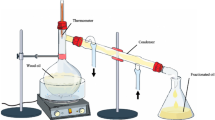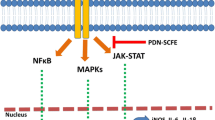Abstract
Objective
To demonstrate the anti-inflammatory activity of Brassica napus L. hydrosols (BNH) in lipopolysaccharide (LPS)-stimulated RAW 264.7 cells.
Methods
Composition analysis of BNH was conducted via gas chromatography-mass spectrometry after BNH were extracted. The nitric oxide (NO) production was measured using the Griess assay. Prostaglandin E2 (PGE2) production was evaluated with enzyme-linked immunosorbent assay. The effects of BNH on LPS-induced pro-inflammatory enzymes including inducible nitric oxide synthase (iNOS) and cyclooxygenase-2 (COX-2) were evaluated using Western blot analysis. Furthermore, phosphorylation of nuclear factor-kappa B (NF-κB) and nuclear translocation of NF-κB p65 were evaluated with Western blot analysis and immunofluorescence staining, respectively.
Results
Compared with LPS-stimulated cells, BNH markedly decreased the generation of NO and PGE2 in LPS-stimulated RAW 264.7 cells (P<0.01 or P<0.05). Moreover, BNH inhibited protein levels of iNOS and COX-2 (P<0.01). Phosphorylation of NF-κB and nuclear translocation of NF-κB p65 was significantly inhibited by BNH (P<0.01 or P<0.05).
Conclusion
The anti-inflammatory activities of BNH were mediated via blockage of the NF-κB signaling pathways in LPS-stimulated RAW 264.7 cells.
Similar content being viewed by others
References
Deng JS, Chi CS, Huang SS, Shie PH, Lin TH, Huang GJ. Antioxidant, analgesic, and anti-inflammatory activities of the ethanolic extracts of Taxillus liquidambaricola. J Ethnopharmacol 2011;137:1161–1252.
Muniandy K, Gothai S, Badran KMH, Kumar SS, Esa NM, Arulselvan P. Suppression of proinflammatory cytokines and mediators in LPS-induced RAW 264.7 macrophages by stem extract of Alternanthera sessilis via the inhibition of the NF-κ B pathway. J Immunol Res 2018;2018:3430684.
Huang C, Li W, Zhang Q, Chen L, Chen W, Zhang H, et al. Anti-inflammatory activities of Guang-Pheretima extract in lipopolysaccharide-stimulated RAW 264.7 murine macrophages. BMC Complement Altern Med 2018;18:46.
Arulselvan P, Tan WS, Gothai S, Muniandy K, Fakurazi S, Esa NM, et al. Anti-inflammatory potential of ethyl acetate fraction of Moringa oleifera in downregulating the NF-κ B signaling pathway in lipopolysaccharide-stimulated macrophages. Molecules 2016;21:11.
Li RJ, Gao CY, Gue C, Zhou MM, Luo J, Kong LY. The anti-inflammatory activities of two major withanolides from Physalis minima via acting on NF-κ B, STAT3, and HO-1 in LPS-stimulated RAW 264.7 cells. Inflammation 2017;40:401–413.
Chang YC, Li PC, Chen BC, Chang MS, Wang JL, Chiu WT, et al. Lipoteichoic acid-induced nitric oxide synthase expression in RAW 264.7 macrophages is mediated by cyclooxygenase-2, prostaglandin E2, protein kinase A, p38 MAPK, and nuclear factor-κ B pathways. Cell Signal 2006;18:1235–1243.
Jin SE, Kim OS, Yoo SR, Seo CS, Kim Y, Shin HK, et al. Anti-inflammatory effect and action mechanisms of traditional herbal formula Gamisoyo-san in RAW 264.7 macrophages. BMC Complement Altern Med 2016;16:219.
Saeidnia S, Gohari A. Importance of Brassica napus as a medicinal food plant. J Med Plant Res 2012;6:2700–2703.
El-Beltagi H, Mohamed AA. Variations in fatty acid composition, glucosinolate profile and some phytochemical contents in selected oil seed rape (Brassica napus L.) cultivars. Grasas Aceites 2010;61:143–150.
Farag MA, Sharaf Eldin MG, Kassem H, Abou el Fetouh M. Metabolome classification of Brassica napus L. organs via UPLC-QTOF-PDA-MS and their anti-oxidant potential. Phytochem Anal 2013;24:277–287.
Auger B, Marnet N, Gautier V, Maia-Grondard A, Leprince F, Renard M, et al. A detailed survey of seed coat flavonoids in developing seeds of Brassica napus L. J Agric Food Chem 2010;58:6246–6256.
Velasco P, Francisco M, Moreno DA, Ferreres F, García-Viguera C, Cartea ME. Phytochemical fingerprinting of vegetable Brassica oleracea and Brassica napus by simultaneous identification of glucosinolates and phenolics. Phytochem Anal 2011;22:144–152.
Fritsche S, Wang X, Li J, Stich B, Kopisch-Obuch FJ, Endrigkeit J, et al. A candidate gene-based association study of tocopherol content and composition in rapeseed (Brassica napus). Front Plant Sci 2012;3:129–129.
Elhiti M, Yang C, Belmonte MF, Gulden RH, Stasolla C. Transcriptional changes of antioxidant responses, hormone signalling and developmental processes evoked by the Brassica napus SHOOTMERISTEMLESS during in vitro embryogenesis. Plant Physiol Biochem 2012;58:297–311.
Horie S, Okuda C, Yamashita T, Watanabe K, Kuramochi K, Hosokawa M, et al. Purified canola lutein selectively inhibits specific isoforms of mammalian DNA polymerases and reduces inflammatory response. Lipids 2010;45:713–721.
Xue Z, Yu W, Liu Z, Wu M, Kou X, Wang J. Preparation and antioxidative properties of a rapeseed (Brassica napus) protein hydrolysate and three peptide fractions. J Agric Food Chem 2009;57:5287–5293.
Kabiri Rad M, Neamati A, Boskabady MH, Mahdavi-Shahri N, Mahmoudabady M. The preventive effect of Brassica napus L. oil on pathophysiological changes of respiratory system in experimental asthmatic rat. Avicenna J Phytomed 2013;3:56–63.
Inouye S, Takahashi M, Abe S. Inhibitory activity of hydrosols, herbal teas and related essential oils against filament formation and the growth of Candida albicans. Jpn J Med Mycol 2009;50:243–251.
Ko EY, Cho SH, Kang K, Kim G, Lee JH, Jeon YJ, et al. Anti-inflammatory activity of hydrosols from Tetragonia tetragonoides in LPS-induced RAW 264.7 cells. EXCLI J 2017;16:521–530.
Sağdiç O. Sensitivity of four pathogenic bacteria to Turkish thyme and oregano hydrosols. LWT-Food Sci Technol 2003;36:467–473.
Kunicka-Styczyńska A, Śmigielski K, Prusinowska R, Rajkowska K, Kuśmider B, Sikora M. Preservative activity of lavender hydrosols in moisturizing body gels. Lett Appl Microbiol 2015;60:27–32.
Ozturk I. Antifungal activity of propolis, thyme essential oil and hydrosol on natural mycobiota of sucuk, a Turkish fermented sausage: monitoring of their effects on microbiological, color and aroma properties. J Food Process Preserv 2015;39:1148–1158.
Prusinowska R, Śmigielski K, Stobiecka A, Kunicka-Styczyńska A. Hydrolates from lavender (Lavandula angustifolia )-their chemical composition as well as aromatic, antimicrobial and antioxidant properties. Nat Prod Res 2016;30:386–393.
Moazeni M, Larki S, Saharkhiz MJ, Oryan A, Ansary Lari M, Mootabi Alavi A. In vivo study of the efficacy of the aromatic water of Zataria multiflora on hydatid cysts. Antimicrob Agents Chemother 2014;58:6003-6008.
Lin JY, Li CY. Proteinaceous constituents of red cabbage juice increase IL-10, but decrease TNF-α secretions using LPS-stimulated mouse splenocytes. J Food Drug Anal 2010;18:15–23.
Shin JS, Noh YS, Lee YS, Cho YW, Baek NI, Choi MS, et al. Arvelexin from Brassica rapa suppresses NF-κ B-regulated pro-inflammatory gene expression by inhibiting activation of Iκ B kinase. Br J Pharmacol 2011;164:145–158.
Hirayama D, Iida T, Nakase H. The phagocytic function of macrophage-enforcing innate immunity and tissue homeostasis. Int J Mol Sci 2018;19:92.
Stunault MI, Bories G, Guinamard RR, Ivanov S. Metabolism plays a key role during macrophage activation. Mediators Inflamm 2018;2018:2426138.
Heo SJ, Yoon WJ, Kim KN, Ahn GN, Kang SM, Kang DH, et al. Evaluation of anti-inflammatory effect of fucoxanthin isolated from brown algae in lipopolysaccharidestimulated RAW 264.7 macrophages. Food Chem Toxicol 2010;48:2045–2051.
Kim BC, Choi JW, Hong HY, Lee SA, Hong S, Park EH, et al. Heme oxygenase-1 mediates the anti-inflammatory effect of mushroom Phellinus linteus in LPS-stimulated RAW264.7 macrophages. J Ethnopharmacol 2006;106:364–371.
Pan C, Gu Y, Zhang W, Zheng Y, Peng L, Deng H, et al. Dynamic changes of lipopolysaccharide levels in different phases of acute on chronic hepatitis B liver failure. PLoS One 2012;7:e49460.
Herbert SBB. Efficacy of the newest COX-2 selective inhibitors in rheumatic disease. Curr Pharm Des 2007;13:2228–2236.
Wang J, Si YF, Wu C, Sun L, Ma YD, Ge AL, et al. Lipopolysaccharide promotes lipid accumulation in human adventitial fibroblasts via TLR4-NF-κ B pathway. Lipid Health Dis 2012;11:139.
Minghetti L. Cyclooxygenase-2 (COX-2) in inflammatory and degenerative brain diseases. J Meurophath Exp Neur 2004;63:901–910.
Park MH, Hong JT. Roles of NF-κ B in cancer and inflammatory diseases and their therapeutic approaches. Cells 2016;5:15.
Dong J, Li J, Cui L, Wang Y, Lin J, Qu Y, et al. Cortisol modulates inflammatory responses in LPS-stimulated RAW 264.7 cells via the NF-κ B and MAPK pathways. BMC Vet Res 2018;14:30.
Tong WZ, Chen XX, Song X, Chen YQ, Jia RY, Zou YF, et al. Resveratrol inhibits LPS-induced inflammation throgh suppressing the signaling cascades of TLR4-NF-κ B/MAPKs/IRF3. Exp Ther Med 2020;19:1824–1834.
Baeuerle PA, Baltimore D. NF-κ B: ten years after. Cell 1996;87:13–20.
Pahl HL. Activators and target genes of Rel/NF-κ B transcription factors. Oncogene 1999;18:6853–6866.
Li Q, Verma IM. NF-κ B regulation in the immune system. Nat Rev Immunol 2002;2:725–734.
Wang HMD, Fu L, Cheng CC, Gao R, Lin MY, Su HL, et al. Inhibition of LPS-induced oxidative damages and potential anti-inflammatory effects of Phyllanthus emblica extract via down-regulating NF-κ B, COX-2, and iNOS in RAW 264.7 cells. Antioxidants 2019;8:270.
Author information
Authors and Affiliations
Contributions
K.N.K. supervised and designed the study. S.H.C., S.R.K., M.S.J., M.C., and S.J.P performed experimental analysis. S.H.C. and K.N.K wrote the manuscript.
Corresponding author
Additional information
Conflict of Interest
The authors declare that they have no conflict of interest.
Supported by the Korea Basic Science Institute (No. C38915 and C030360)
Electronic supplementary material
Rights and permissions
About this article
Cite this article
Cho, SH., Kim, S.R., Jeong, M.S. et al. Protective Effect of Brassica napus L. Hydrosols against Inflammation Response in RAW 264.7 Cells. Chin. J. Integr. Med. 27, 273–279 (2021). https://doi.org/10.1007/s11655-021-3330-9
Accepted:
Published:
Issue Date:
DOI: https://doi.org/10.1007/s11655-021-3330-9




